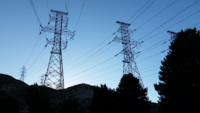
Photo from wikipedia
Abstract Using the direct current power flow model, we study cascading failures and their spatial and temporal properties in the U.S. Western Interconnection (USWI) power grid. We show that yield… Click to show full abstract
Abstract Using the direct current power flow model, we study cascading failures and their spatial and temporal properties in the U.S. Western Interconnection (USWI) power grid. We show that yield (the fraction of demand satisfied after the cascade) has a bimodal distribution typical of a first-order transition. The single line failure leads either to an insignificant power loss or to a cascade which causes a major blackout with yield less than 0.8. The former occurs with high probability if line tolerance α (the ratio of the maximal load a line can carry to its initial load) is greater than 2, while a major blackout occurs with high probability in a broad range of 1 < α < 2. We also show that major blackouts begin with a latent period (with duration proportional to α) during which few lines overload and yield remains high. The existence of the latent period suggests that intervention during early stages of a cascade can significantly reduce the risk of a major blackout. Finally, we introduce the preferential Degree And Distance Attachment model to generate random networks with similar degree, resistance, and flow distributions to the USWI. Moreover, we show that the Degree And Distance Attachment model behaves similarly to the USWI against failures.
Journal Title: Network Science
Year Published: 2018
Link to full text (if available)
Share on Social Media: Sign Up to like & get
recommendations!